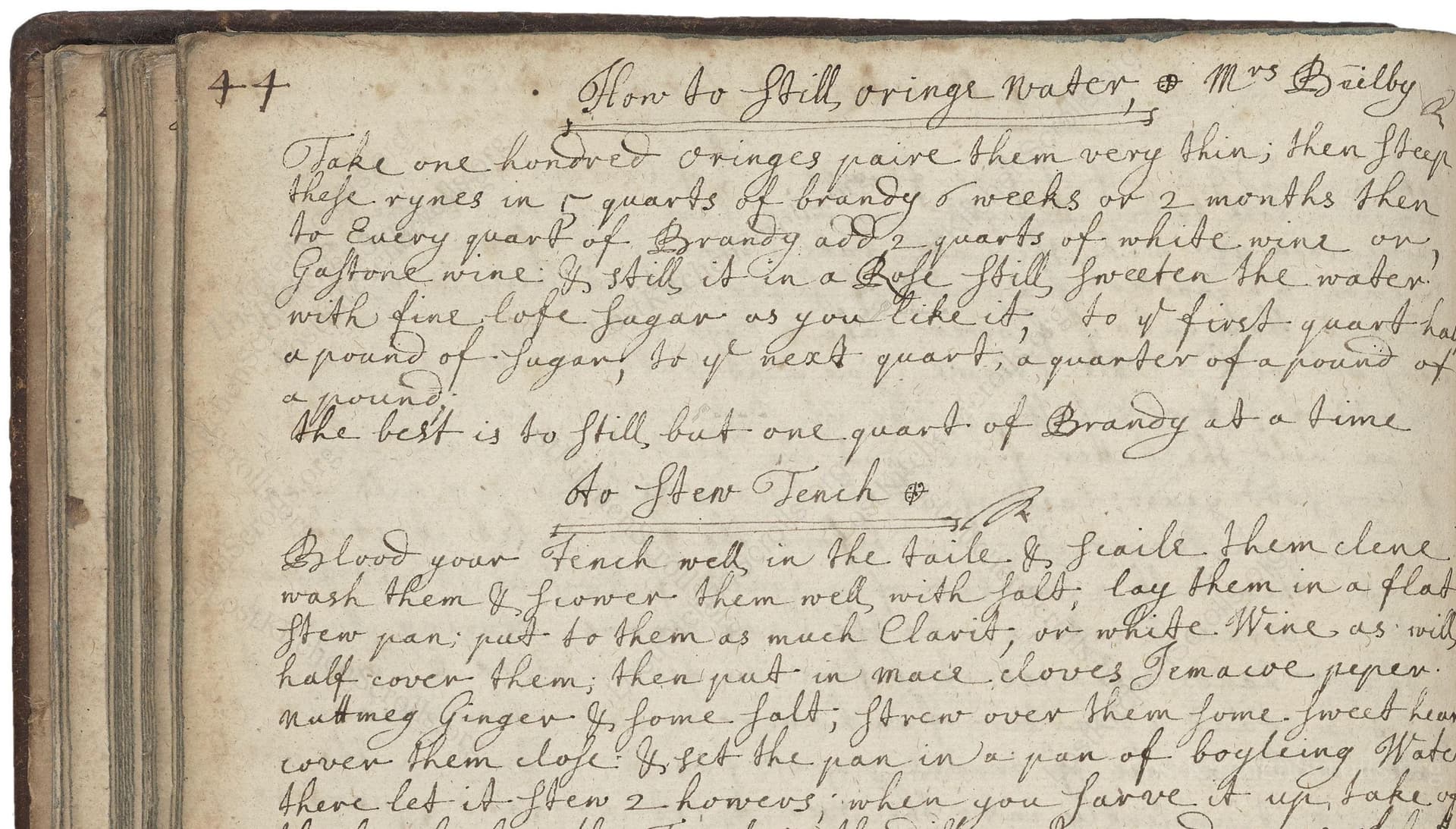How To Still Oringe Water & Mrs Bielby
From the treasured pages of Cookbook of Jane Dawson
Written by Jane Dawson

How To Still Oringe Water & Mrs Bielby
"Take one hundred oringe, paire them very thin; then Steep these rynes in 7 quarts of brandy 6 weeks or 2 months then to Every quart of Brandy add 2 quarts of white wine or, Gaftone wine. Still it in a Rofe Still, Sweeten the water, with fine loafe Sugar, a pound of Sugan to a pound. as you like it, to ye first quart halfe a pound of Sugan to ye next quart, a quarter of a pound, ye best is to Still, but one quart of Brandy at a time."
Note on the Original Text
Early modern recipes like this were written as brief procedural notes, expecting the knowledgeable reader to fill in gaps from experience. Proportions were rarely exact; container sizes and sugar amounts were adjusted to household taste and scale. Spelling reflects regional pronunciation ('su'gar as 'sugan' or 'loafe' sugar for 'loaf sugar'), and the grammar is conversational. The word 'Still' here refers to both the act of distilling and the apparatus, 'Rofe Still' is 'rose still', and 'Sugan' is 'sugar'. The recipe was likely shared among women as a transmission of domestic science rather than strict instruction, offering flexibility for household adaptation.

Title
Cookbook of Jane Dawson (1690)
You can also click the book image above to peruse the original tome
Writer
Jane Dawson
Era
1690
Publisher
Unknown
Background
A delightful glimpse into late 17th-century English kitchens, Jane Dawson's recipe collection is a flavorful tapestry of sweet delicacies and savory dishes, revealing the tastes and ingenuity of bygone home cooks.
Kindly made available by
Folger Shakespeare Library
This delightful orange water recipe hails from late 17th-century England and is attributed to Jane Dawson, an accomplished lady and manuscript recipe collector. Culinary distillations were a popular pastime among well-to-do women, blending domestic science and fragrant pantry luxury. Flavored waters and spirits like this were used for medicinal purposes, confectionery, and in high-status desserts. The ability to preserve and infuse the zest of exotic imported oranges also demonstrated status and refinement. Brandy was a common extracting spirit in England at the time, and distillation at home signaled access to advanced tools and culinary know-how.

In Jane Dawson’s kitchen, the central tool for this recipe was the rose still — an early kind of alembic, often made of copper or glazed earthenware, used for flavor extractions. Citrus peel was carefully pared with a small, sharp knife. The brandy and wine infusion would rest in large glazed ceramic or glass jars, often sealed with parchment or waxed cloth. The sweetened orange water was stored in glass bottles, sometimes stoppered with wax. Modern recreation of this recipe might use a micro-distillation unit or a small copper alembic still. The key is gentle, slow distillation in small batches to preserve delicate citrus aromatics.
Prep Time
1 hr 30 mins
Cook Time
4 hrs
Servings
100
We've done our best to adapt this historical recipe for modern kitchens, but some details may still need refinement. We warmly welcome feedback from fellow cooks and culinary historians — your insights support the entire community!
Ingredients
- 100 fresh oranges (use zest only, approximately 1.1 lb zest)
- 1.85 gallons brandy (40% ABV, unflavored)
- 3.7 gallons dry white wine (e.g., Sauvignon Blanc or other dry white)
- Granulated white sugar, up to 1 lb 10 oz (or to taste)
Instructions
- Peel 100 oranges, taking care to pare off only the thinnest layer of zest, avoiding the bitter white pith.
- Place these zest strips into a large glass container and cover with 1.85 gallons of brandy.
- Allow the mixture to steep for 6 to 8 weeks in a cool, dark place, shaking occasionally.
- After the infusion period, for every 1 quart of brandy infusion, add 2 quarts of a dry white wine.
- If available, Sauvignon Blanc or an unoaked white similar to 'Gascoigne wine' (likely a French country white) is ideal.
- Distill this mixture in small batches — about 1 quart at a time — using a traditional rose still or, in modern kitchens, a small copper still or countertop distiller.
- Sweeten the resulting orange water with fine granulated sugar: add up to 1.1 lb sugar to the first quart, 9 oz to the next, and adjust to taste.
- Allow to rest another few days to let flavors meld and any cloudiness settle before bottling.
Estimated Calories
160 per serving
Cooking Estimates
You will spend about 1.5 hours peeling oranges and preparing the ingredients, plus a short amount of time per distillation batch. The orange zest steeps in brandy for 6 to 8 weeks, but that does not need your active attention. The calories are estimated for a typical 60ml (2 oz) serving.
As noted above, we have made our best effort to translate and adapt this historical recipe for modern kitchens, taking into account ingredients nowadays, cooking techniques, measurements, and so on. However, historical recipes often contain assumptions that require interpretation.
We'd love for anyone to help improve these adaptations. Community contributions are highly welcome. If you have suggestions, corrections, or cooking tips based on your experience with this recipe, please share them below.
Join the Discussion
Rate This Recipe
Dietary Preference
Main Ingredients
Culinary Technique

Den Bockfisch In Einer Fleisch Suppen Zu Kochen
This recipe hails from a German manuscript cookbook compiled in 1696, a time whe...

Die Grieß Nudlen Zumachen
This recipe comes from a rather mysterious manuscript cookbook, penned anonymous...

Ein Boudain
This recipe comes from an anonymous German-language manuscript cookbook from 169...

Ein Gesaltzen Citroni
This recipe, dating from 1696, comes from an extensive anonymous German cookbook...
Browse our complete collection of time-honored recipes



